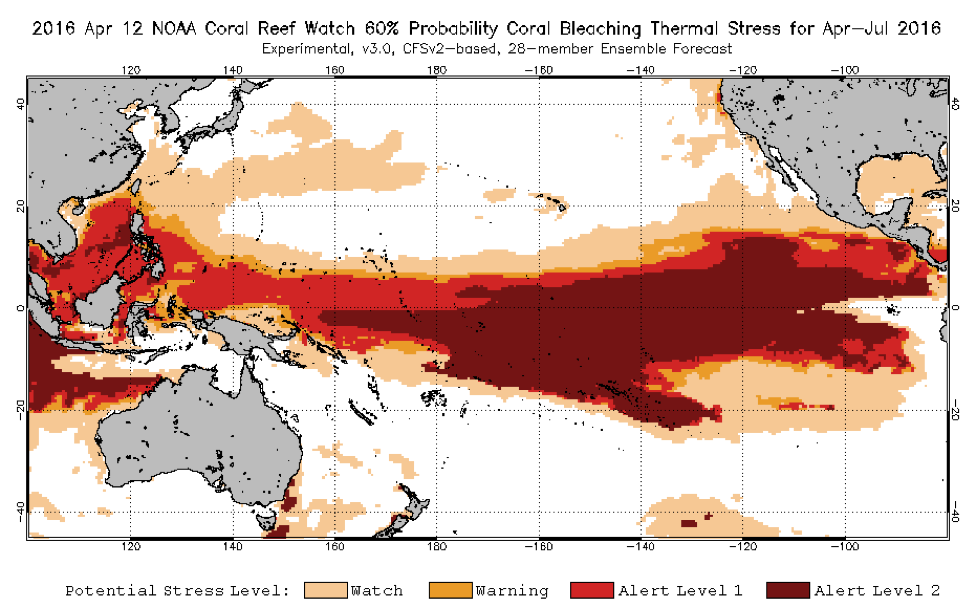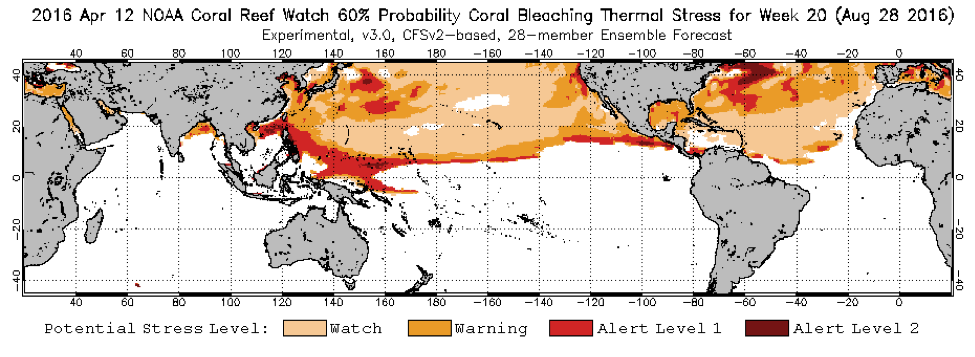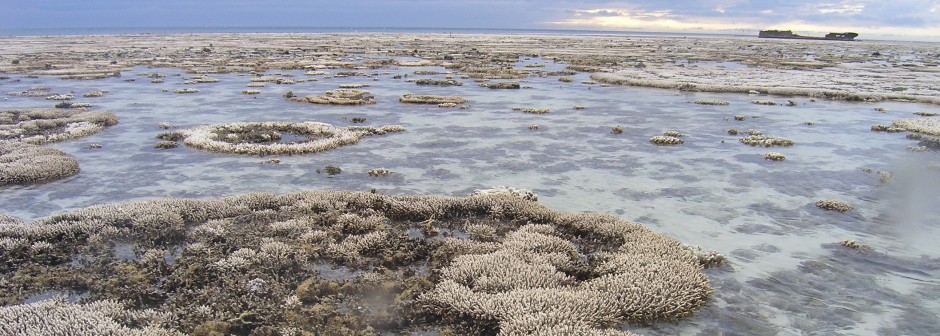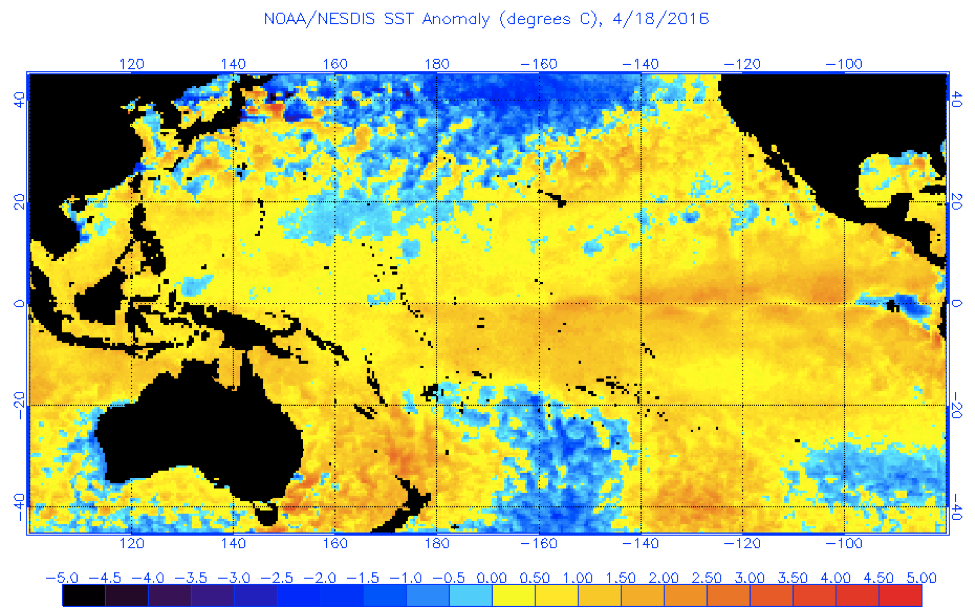The past month has brought with it some of the worst coral bleaching in recent years. The severity of the bleaching brought it to the attention of the New York Times, which ran a front-page article on the global bleaching event on April 10. The article provided a short summary of the current extent of the bleaching. Kiribati and the Great Barrier Reef have been more affected than any other reefs at this point in time. Parts of Kiribati are already appearing brown and fuzzy, which means that the corals have died and are being overgrown with macroalgae [1]. The northern part of the Great Barrier Reef has long been considered to be one of the most pristine reefs in the world. Unfortunately, scientists are predicting 50% mortality for the northern part of the reef (Figure 1). Luckily, the remains of a typhoon passed over the southern third of the Great Barrier Reef and were able to bring cooler water and increase the turbidity of the water, which gave the corals temporary relief from the heat and direct sunlight. The southern part of the reef will not see as much bleaching as the northern reef [2].
Fortunately, these past few months have left Hawaiian reefs intact. The “Blob” of hot water that has been stretched between the Americas and Southeast Asia and Australia hasn’t expanded up to Hawaii yet. Instead, the Blob appears to be getting smaller, which bodes well for Pacific reefs [1]. The hot water transported by El Niño has also missed Hawaii. The next area affected by El Niño will most likely be the Indian Ocean, which is already starting to experience some bleaching, especially in the Maldives [3]. However, Coral Reef Watch is predicting that temperatures in the northern Pacific Ocean will continue to increase throughout the year (Figures 2 and 3). This makes sense intuitively because the northern hemisphere is just now reaching its hotter months, whereas the southern hemisphere is finally coming to its colder months. Sea surface temperature (SST) largely follows seasonal patterns but lags a bit behind.

Figure 2. Coral reef bleaching risk predictions for April – July 2016. source: NOAA Coral Reef Watch

Figure 3. Coral reef bleaching risk predictions for week of August 28, 2016. source: NOAA Coral Reef Watch
Hawaii has not been completely unaffected by the conditions of the last few months. While SST has not gotten high enough to induce mass bleaching, it has been higher than normal (Figure 4). One measure of stress to coral reefs is “degree heating.” Degree heating is quantified using two parameters: the number of weeks that the SST has been that high and the difference between the average SST of the hottest month of the year and the average SST of the time period being observed [4]. For example, if a reef experienced a 4°C-heating week it could have experienced one week of temperatures 4°C higher than average, one week of temperatures 2°C higher than average and two weeks of temperatures 1°C higher than average, four weeks of temperatures 1°C higher than average, or a number of other combinations.
Hawaii has not experienced any degree heating weeks (DHWs) in 2016, but had a stretch of almost 12°C-heating weeks in the fall of 2015. Figure 5 shows DHWs and temperatures for the island of Oahu. Last year (2015) is represented with the thin black line. The peak rising from the bottom right of the figure shows how much heat stress the corals had. This year (2016) is represented with the thick black line. Already, you can see that the temperature has been on the warmer end of the “normal” spectrum.

Figure 5. Sea surface temperature trends for Oahu (January 1, 2001 – April 18, 2016). source: NOAA Coral Reef Watch
It is likely that more corals in Hawaii will bleach this fall, probably sometime around September. Predictions released by Coral Reef Watch trend towards higher temperatures in the northern hemisphere as the year progresses. The four-month outlook (April – July) reaches a “Watch” in Hawaii, and the weekly outlook for August 28 shows at least a Watch in most of the northern hemisphere (Figures 2 and 3). Based on these models and past temperature trends, it is not a stretch to predict more bleaching this fall in Hawaii.
It is becoming increasingly obvious that climate change and nutrient pollution are combining to have worse effects on coral than either would alone. In a study published in 2015, Michael Gil and colleagues found that herbivores might not be able to counter effects of nutrient addition in real systems. Previous studies have found that herbivores have an effect at small scales, but this research found that at larger scales herbivores are less effective [5]. The study has implications for coral survival because nutrient enrichment increases algal populations and thus increases competition with corals. Herbivores reduce some of this competition, but this study implies that herbivores may not be able to do enough.
Another study done by Keisha Bahr and colleagues provided some good news. Bahr looked at how sensitive five coral species native to Hawaii were to increased temperature and increased concentrations of carbon dioxide in the water. The study found that some coral species are particularly resistant to both high temperature and high carbon dioxide concentration. Overall, high temperature caused more mortality than high carbon dioxide concentration, but the study also found that the results varied between species. This has implications for predicting the health of corals in the future because it shows that each coral behaves differently [6].
Together, these studies remind us that although some corals are resilient, we must continue to make efforts to decrease our impacts on the ocean. The recent bleaching event is expected to continue on into 2017, which will make it one of the longest periods of stress for corals in recent history. If we don’t want corals to disappear, we must change our actions and increase our efforts to help corals survive.
References:
[1] Innis, Michelle. “Climate-Related Death of Coral Around World Alarms Scientists.” The New York Times, April 10, 2016. Accessed April 18, 2016.
[2] Cressey, Daniel. “Coral Crisis: Great Barrier Reef Bleaching Is ‘the Worst We’ve Ever Seen’.” Nature, April 13, 2016. Accessed April 18, 2016. doi:10.1038/nature.2016.19747.
[3] NOAA Coral Reef Watch. Maldives 5-km Bleaching Thermal Stress Gauges. Apr. 17, 2016. College Park, Maryland, USA: NOAA Coral Reef Watch. Accessed April 18, 2016.
[4] “NOAA Coral Reef Watch Methodology Page.” NOAA Coral Reef Watch. Accessed April 19, 2016.
[5] Gil, Michael A., Jing Jiao, and Craig W. Osenberg. “Enrichment Scale Determines Herbivore Control of Primary Producers.” Oecologia 180, no. 3 (November 14, 2015): 833-40. Accessed April 18, 2016. doi:10.1007/s00442-015-3505-1.
[6] Bahr, Keisha D., Paul L. Jokiel, and Ku’Ulei S. Rodgers. “Relative Sensitivity of Five Hawaiian Coral Species to High Temperature under High-pCO2 Conditions.” Coral Reefs, 2016. Accessed April 18, 2016. doi:10.1007/s00338-016-1405-4.



